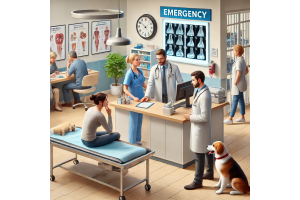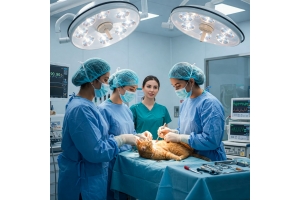Care and Feeding of Orphaned Puppies and Kittens

Housing
• Use a box with tall sides to avoid escape, such as a cardboard pet carrier.
• Line the bottom of the box with towels and place a diaper or pee pad on top for easy cleaning.
• The box will need to be cleaned frequently to keep the neonates clean and dry.
Temperature
• Neonates are unable to maintain their own body heat; they rely on the ambient temperature and littermates.
• The environment should be draft free with a ambient temperature gradient measured by a thermometer.
• Electric heating pads and heat lamps should not be used due to the risk of overheating and burns.
• The ambient temperature should be 85–90° F for the first week, 80° F for weeks 2–4, and 70° F for week 5.
Diet
• Commercial replacement diets (e.g. Lactol, Petlac and R/C Baby milk) are the best choice for diet replacement.
• When commercial diets are not available, the following recipe can be used in the interim.
2 cup whole milk,
2 cup water, 1 drop multivitamins, 2 egg yolks, 2 Tums (antacid) crushed
Blend all ingredients in a blender, keep refrigerated, and use within 48 hours.
• The above diet provides 1.2 kcal/mL, which is the same as commercial diets.
• Neonates are fed 22–26 kcal/100 g body weight for the first 12 weeks of life. The diet should be gradually increased over 2–3 days to the recommended daily amount to avoid overfeeding and diarrhea.
Feeding
• The neonate will cry when hungry, but feeding should initially be expected every 2–3 hours. Capacity of stomach is approximetly 40ml per kg body weight (Better to calculate milk based on their BW )
• Warm the formula to a comfortable temperature, place the neonate in a comfortable dorsal position, and hold the bottle up in a position to closely mimic that of the mother. Ensure that the nipple does not contain air and the bottle is tipped up to avoid air ingestion. Neonates have a vigorous suckling response and can overfeed if not monitored.
Milk bubbling out of the neonate’s nose may indicate overzealous feeding or a hole in the nipple that is too large. A satisfied neonate is quiet with a slightly enlarged abdomen. Following each feeding, burping may be necessary to expel excess air ingested.
• A nipple bottle is most commonly used, but a feeding tube can be ideal in skilled hands for weak or premature neonates
• With all methods of feeding, care should be taken to avoid aspiration pneumonia, a complication seen with forced nursing, squeezing the bottle, improper feeding tube use, and volume overload.
Health
• Hydration should be monitored in the neonate by mucus membranes, eyes, urine specific gravity, and urine color.
• A neonate should gain 10% of its birth weight daily.
• Crying for >15 minutes is a sign of distress (e.g., hunger, cold, neglected, pain).
Urination and Defecation
• For the first 3 weeks, the neonate must be stimulated to urinate and defecate after each feeding.
• With the neonate held securely in 1 hand (possibly with a towel) over a sink, gently massaging the lower abdomen in a circular motion. The genitals may also be rubbed with a warm, moist cotton ball.
• The genitals should be cleaned and dried to avoid skin irritation.
• Urine and feces should be seen at almost every feeding and in the box.
• Feces should be soft, but not green or yellow watery. Overfeeding is the most common cause of diarrhea; further dilute the formula by 1/3 for 2 days.
Client Education: Home Dental Care
Home dental care should be a daily part of each animal’s life. The commitment to time, energy, and resources from the owner will impact the quantity and quality of their animal’s life.
Supplies:
• Toothbrush (e.g., fingerbrush, pet toothbrush, human toothbrush), gauze, washcloth
• Veterinary toothpaste, beef bouillon, garlic or tuna water
Age:
• Home dental care should begin at 8–12 weeks of age. Brushing is not critical until the adult teeth erupt, but starting early allows the animal to become accustomed to the procedure during an impressionable period of development.
Introduction:
• Regardless of age, introduce brushing slowly and gradually, allowing the animal to determine the amount of time at each stage.
• As each step is begun, observe for the animal’s reaction and only advance to the next step once the animal is comfortable.
• Massage the animal’s muzzle and lips gently.
• Introduce your finger dipped in garlic water or meat soup (canine) or tuna water (feline) into the buccal pouch under the upper lip and rub the gum line.
• Introduce your finger covered with a gauze, washcloth and rub the gum line and teeth in a circular motion.
• Introduce a pet toothbrush or a very soft human toothbrush held at a 45° angle to the tooth surface, brushing in a oval motion.
• Introduce the toothbrush with veterinary toothpaste.
• As the animal accepts the procedure, brushing of the lingual surfaces can begin.
• Place the nonbrushing hand over the muzzle and tilt head backward to open the animal’s mouth.
• Brush the visible teeth (opposite side) and then repeat on the other side.
Maintenance:
• Brush daily, at a minimum of 3 times a week.
Oral examination:
At the time of brushing always examine the teeth for:
• Gums: redness, swelling, bleeding, pus
• Teeth: loss, instability, broken, change in color
• Mouth: halitosis (bed smell), growth.
Adjuncts to brushing:
• Dental diets or treats
• Rawhide bones (e.g., Nylabone)
• Yearly dental examinations and cleanings, if needed
Tips for successful brushing:
• Select the same time each day to brush so the animal expects it (routine and repetition).
• Brushing in the evening is often preferred as everyone is in a more quiet mood.
• Sessions should be short, roughly 2–3 minutes.
• Offer praise and reassurance during and following the brushing.
Avoid:
• Human toothpaste, baking soda, or hydrogen peroxide
• Heavy restraint
• Brushing aggressively
• Brushing if the procedure may cause pain (e.g., recent thorough oral examination, exposed pulp cavities, gingivitis, ulcerations, tooth mobility)
• Natural bones, cow hooves, hard nylon toys as they may fracture teeth






